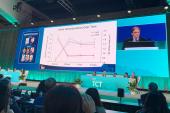Debate Continues on TAVI Choice for Women With Small Annuli
New SMART trial data convince some to use self-expanding valves due to better hemodynamics. Others remain cautious.

PARIS, France—As expected, women with small aortic annuli seem to have better hemodynamic outcomes at 1 year following TAVI with self-expanding devices compared with balloon-expandable valves, according to a subgroup analysis from the SMART trial.
Women made up 87% of the SMART trial population, so it’s unsurprising that the new subgroup data mirror those of the original findings. According to presenter Roxana Mehran, MD (Icahn School of Medicine at Mount Sinai, New York, NY), that’s enough to convince her that a self-expanding bioprosthesis should be used preferentially in women with small annuli.
“I'm a woman. If I have a small annulus, I'd rather have a better hemodynamic at follow-up,” she said following her presentation at EuroPCR 2024. “At this point, with what I have seen [and] what we have shown, absolutely, that [in a] woman with a small annulus, I think we have definitive answers. All things being equal, which hemodynamic would you like to have? The one that gives you a lower gradient and higher effective orifice area, less PPM, less AR, better quality of life? I think so.”
As previously reported by TCTMD, the overall SMART trial showed that, compared with a balloon-expandable valve, TAVI with a self-expanding supra-annular valve resulted in similar rates of clinical outcomes at 1 year and lower rates of bioprosthetic dysfunction in patients with symptomatic severe aortic stenosis and a small aortic annulus. At the time, observers raised questions about the definition of “dysfunction” as well as the use of VARC 2 (not VARC 3) definition of clinical valve thrombosis used in the trial.
Today, other cardiologists who spoke with TCTMD at the meeting were less enthusiastic than Mehran, urging caution before making that leap in practice.
Julia Mascherbauer, MD (Medical University of Vienna, Austria), told TCTMD the decision of which valve type to use in women depends on many factors including lifetime management, patient age, the presence or risk of coronary artery disease, and anatomy. “We should be very aware that women have smaller annuli and that this is a major risk for probably more structural valve degeneration,” she said. “We have so far no signal that a self-expanding valve will lead to better outcomes clinically. We have no data.”
The findings will not change her practice at all, Mascherbauer added.
Similarly, Rajesh Kharbanda, MD, PhD (University of Oxford, England), who served as a discussant during the session, called the data “interesting” but said they are not definitive. Without any evidence on long-term clinical outcomes, especially regarding the effect of patient-prosthesis mismatch (PPM), “it's persuasive, but it needs more data to be a class 1 recommendation,” he told TCTMD.
Substudy Findings
For the study, Mehran and colleagues included the 637 female patients (mean age 80.2 years) from the SMART trial who were randomized to receive TAVI with the supra-annular Evolut PRO/PRO+/FX (Medtronic; n = 320) or intra-annular SAPIEN 3/3 Ultra (Edwards Lifesciences; n = 317) devices.
As in the main trial, the composite rate of death, disabling stroke, or rehospitalization for heart failure at 1 year was similar for those in the self-expanding compared with balloon-expandable valves (9.4% vs 11.8%; P = 0.35).
However, the rate of bioprosthetic valve dysfunction at 1 year was significantly lower following TAVI with self-expanding compared with balloon-expandable valves (8.4% vs 41.8%; P < 0.001). Additionally, effective orifice area was higher (1.97 vs 1.49 cm2) and mean gradient was lower (7.7 vs 15.8 mm Hg) for those who received self-expanding devices (P < 0.001 for both).
Further, mild or moderate aortic regurgitation (AR) at 12 months was less often reported in the self-expanding versus balloon-expandable device group (12.3% vs 18.8%; P = 0.04). PPM as defined by VARC 3 was also less common following TAVI with self-expanding devices (severe 1.7% vs 9.9%; moderate 9.4% vs 27.5%; P < 0.001). The PPM outcomes were observed regardless of body mass index.
Lastly, quality of life was either slightly better or similar with self-expanding compared with balloon-expandable devices as assessed by both the Kansas City Cardiomyopathy Questionnaire (76.8% vs 69.2% improvement; P = 0.037) and New York Heart Association class (P = 0.281), respectively.
“Long-term follow-up is planned and is needed to assess the impact of these important hemodynamic differences on the clinical outcomes that will follow,” Mehran said.
What Valve to Use?
During the session, Thomas Modine, MD, PhD (CHU de Bordeaux – Haut- Lévêque, France), questioned whether Mehran’s take on wanting to use self-expanding valves in all women is “a bit minimalistic.”
“Women are not just small men,” she replied. “Certainly, there are very important biological differences in how aortic stenosis affects the sexes. Please note this. Women have less calcifications. They have different remodeling. In fact, the aortic root is similar, but the annulus seems to be smaller. But the truth is, what we have here is definitive evidence that perhaps a supra-annular valve that gives you a larger effective orifice area and better hemodynamics may lead . . . to a better outcome and perhaps it would be a better platform for women.”
Further, Mehran emphasized, “this is the first powered, randomized clinical trial that used a characteristic that happens to be more often seen in women, and therefore we enrolled 90% women. Let's do more of these trials!”
Following the presentation, Mascherbauer commented that she shares Mehran’s enthusiasm for this topic, especially because “we are treating more and more young woman now, because women have a small annulus and more and more women are more or less rejected by the surgeons.” She pointed out, however, that many patients, especially those 65 or younger, will go on to have coronary artery disease: “Now my concern is if I implant a self-expanding platform that has worse access to the coronaries, what will I do?”
Mehran validated these concerns and encouraged further thought regarding lifetime management. “I can promise you that platforms will continue to evolve, and they already have,” she said. “Within the Evolut platform, we have larger cell sizes to be able to get that better access. There are so many different ways to approach this, and you should not be sending your young patient to surgery if your surgeon isn't willing to enlarge the aortic annulus.”
Kharbanda noted the general importance of this trial in that it enrolled so many women when no other valve trial has managed to do so. “I think it's a fantastic trial,” he said. “The fact that it's got so many women is important. I think cardiovascular trials have underrepresented women in the past, and I think we need to gather the evidence. I also think we need to think about how we use real-world registry data to inform us about outcomes, particularly by sex.”
Yael L. Maxwell is Senior Medical Journalist for TCTMD and Section Editor of TCTMD's Fellows Forum. She served as the inaugural…
Read Full BioSources
Mehran R. Small aortic annuli patients treated with TAVI: outcomes in women in the SMART trial. Presented at: EuroPCR 2024. May 14, 2024. Paris, France.
Disclosures
- The SMART trial was funded by Medtronic.
- Mehran reports receiving grants/research funding from Abbott, Abiomed, Affluent Medical, Alleviant Medical, AM-Pharma, Amgen, Arena, AstraZeneca, AtriCure Inc, Biosensors International, Bristol-Myers Squibb, Cardiawave, CERC, Chiesi Farmaceutici, Cleerly Health, Concept Medical Inc., Cytosorbents, Daiichi Sankyo, Inc., Duke, Element Science, Essential Medical, Faraday, Idorsia, Janssen, MedAlliance, Mediasphere, Medscape, Medtelligence, Medtronic, Novartis, OrbusNeichP&F, Penumbra, PhaseBioName COI Grants/Research Honoraria/Consultation Participation Stock Spouse/Partner Other, Pi-Cardia, PLx Pharma, Population Health Research Institute, Protembis, ReCor Medical, RenalPro, RM Global, Sanofi, and Shockwave Medical; honoraria from ACC and JAMA Cardiology; participation in Affluent Medical, Boehringer Ingelheim, Cardiovascular Research Foundation, Cordis, Daiichi Sankyo, Esperion Science/Innovative Biopharma, Europa Group/Boston Scientific, Henry Ford Health Cardiology, Ionis Pharmaceuticals, IQVIA, Lilly and Company, MedCon International, Novartis, Novo Nordisk, Peerview Institute for Medical Education, Radcliffe, Tarsus Cardiology, Terumo Interventional Systems, Vectura, VoxMedia, and WebMD; holding stock in ControlRad, Elixir Medical, and STEL.
- Kharbanda reports receiving consulting fees/honoraria from Boston Scientific and Medtronic.
- Mascherbauer reports no relevant conflicts of interest.
- Modine reports receiving grants/research funding from Abbott, Edwards Lifesciences, Medtronic, OpSens Medical, and Pi-Cardia; and consulting fees/honoraria from Abbott, Edwards Lifesciences, Medtronic, and MicroPort.





Comments